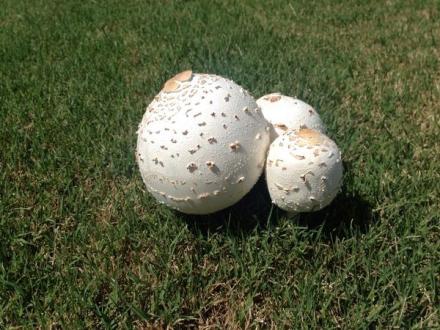By Dr. Mike Fidanza
My earliest memories from childhood are working with my father on his mushroom farm in Avondale, PA. We grew the “white button” mushroom, and today Pennsylvania remains the leading producer of edible mushrooms in the USA. I was always fascinated with the biology of those fungi, and years later I am still investigating mushrooms in the form of the fairy ring complex in turf.
Fairy ring symptoms are the most commonly seen disease disorders of turfgrasses worldwide. Fairy ring is not caused by dancing fairies or woodland elves, but is attributed to more than 60 species of basidiomycete (or mushroom) fungi. Fairy ring occurs on golf course turf, athletic fields and pitches, and lawns and landscapes. Fairy ring can occur on all turfgrass species, all climates, all times of the year, and under any and all turf management programs. These basidiomycetes are wood decaying fungi, typically seeking lignin of tree roots, but lignin and organic matter found in turfgrass thatch and within the turf rootzone is on their menu as well. Fairy ring is a curious oddity of nature, but to the turf practitioner it can be a persistent scourge of turf loss and a disruption of turf quality and function. Seeing mushrooms during a walk in the forest is a thing of beauty, but seeing mushrooms and dead, necrotic turf on your morning turf inspection is not.
Biology of fairy ring
Fairy ring symptoms are classified as Type I, II and III, based on the visual appearance of the affected turf. These symptoms can occur in circles, rings or arcs, because the fungus grows radially from its point of origin in the thatch or soil. Type I is necrotic, dead turf. Type II is dark green, stimulated and lush growing turf. Type III is the appearance of basidiocarps or mushrooms. These three symptoms can occur alone or in pairs or all three at the same spot. The fairy ring fungus does not directly infect turfgrass plants and cause leaf lesions and blights like other pathogens such as Rhizoctonia sp. As the fairy ring fungus colonizes turfgrass thatch and rootzone areas, its mycelium and other substances coat sand and soil particles which can cause severe hydrophobicity or soil water repellency. Thus, turf loss is due in part to wilt simply because the roots can’t access any soil moisture. Also, as the fungus breaks down organic matter, ammonium can accumulate to toxic levels which shuts down root function.
Perhaps our current “sustainable” practices, such as a reduction in fertilizer rates, lower mowing heights, increased use of sand for topdressing and rootzone mixes all contribute to the frequent appearance of fairy ring by favoring the growth and development of these basidiomycetes in our turfgrass systems. Also, long wet/dry cycles—either due to the weather or irrigation practices—seems to be related to the appearance of fairy ring symptoms.
Back on the mushroom farm, I remember irrigating the compost beds heavily and then using high-speed air handlers to dry out the growing rooms in order to stimulate mycelial growth and subsequent mushroom production. So, borrowing from my mushroom farming days, it appears that soil moisture management may be the key to fairy ring control in turf.
Control options
A fairy ring ‘spot’ can be eradicated by carefully removing the sod, digging out and removing the soil, replacing the rootzone mix, and seeding or sodding. This is labor intensive and time consuming, and could turn into a large excavating project. Mushrooms can be mowed off easily, but keep an eye that spot for further symptoms to develop, especially during drought stress periods. On close-cut turf, lush, excessive growth is easily scalped, which can lead to wilting and necrotic, damaged turf anyway.
Type II symptoms can be “masked” with an appropriate dose of nitrogen or iron to get the same dark green color over an entire turf area. In addition to urea or ammonium sulfate, there are other soil approach-related products available from 3Tier Technologies, Grigg Brothers, Floratine, EarthWorks, Aqua-Aid, and others.
Several fungicides are currently labeled for fairy ring in turf. For best results, follow the label very carefully, especially for preventive and/or curative statements, and include some key cultural practices. For example, spike or needle tine or “punch holes” into the affected areas first. This may help get oxygen into the rootzone and displace any toxic gases. Next, apply a wetting agent (or soil surfactant) and immediately water in enough to wet the rootzone to overcome any hydrophobicity.
Apply the fungicide next, and immediately “rinse-in” and wash the product off the turf canopy to the thatch and rootzone target areas. Another time-saving option is to tank-mix the fungicide and wetting agent and apply together followed by irrigation. Again, check the fungicide product label for recommendations on using wetting agents. Keep in mind, repeat applications may be needed for either a preventive or curative program.
It seems that every case of fairy ring is unique and different. It may be severe one year but not the next. What products or practices work on one ball field may not work at another site. As previously mentioned, soil moisture content should be considered when battling fairy ring. Soil moisture monitoring is useful to help make decisions on irrigation practices. Most importantly, the use of wetting agents should help to alleviate those extreme wet/dry cycles associated with the appearance of fairy ring symptoms, and aid in turf recovery.
Fairy ring remains a curious oddity of nature, and managing fairy ring symptoms in turf requires a multi-faceted approach along with patience and persistence.
Mike Fidanza, PhD, is Professor of Plant and Soil Sciences, Penn State University – Berks Campus.


